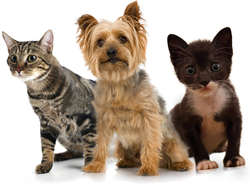Fermented Foods for Furry Friends: Can Pets Benefit from Probiotics Like We Do?
- ER Kent

- Aug 9
- 4 min read
Kefir, yogurt, kimchi—fermented foods are having a gut-health glow-up in human kitchens. But what about our four-legged family members? Can your pet benefit from a spoonful of probiotics, or should you stick to their usual kibble? Let’s dive into the bubbling science of fermented foods for dogs and cats.

The Fermentation Craze—and Why It’s Reaching the Pet Bowl
Fermentation isn’t just a foodie trend. It’s a traditional method of preserving food that also enhances its nutritional profile. During fermentation, beneficial bacteria (aka probiotics) break down sugars and starches, resulting in tangy flavors and loads of gut-friendly microbes.
For humans, the benefits are well-studied—improved digestion, stronger immunity, and better nutrient absorption. But a growing body of research suggests that probiotics can do wonders for pets too, from calming tummy troubles to boosting mood and immunity.

How Probiotics Help Pets
Just like humans, dogs and cats have a complex gut microbiome—an ecosystem of bacteria, fungi, and other microorganisms. When this system is balanced, your pet is likely to be:
More resistant to allergies
Better at absorbing nutrients
Less prone to diarrhea, gas, or bloating
Less reactive to stress or anxiety
Fermented foods provide live beneficial bacteria, which help restore and maintain that balance, especially after antibiotics or digestive upset.

Top Pet-Safe Fermented Foods (And How to Use Them)
Not all fermented foods are created equal—and some that are great for you (like kombucha or spicy kimchi) are definitely not pet-safe. Here are the best options for dogs and cats:
✅ Plain Yogurt (unsweetened, unflavored)
Best for: Dogs and some cats Benefits: Contains active cultures like Lactobacillus acidophilus that promote digestion How to serve: 1–2 teaspoons for small dogs or cats; 1–2 tablespoons for large dogs Watch out: Only use if your pet tolerates dairy well—some pets are lactose intolerant
✅ Kefir (unsweetened, plain)
Best for: Both dogs and cats Benefits: Higher probiotic count than yogurt, easier to digest How to serve: Start with 1 tsp and work up to 1 tbsp depending on pet size Bonus: Contains strains that fight yeast overgrowth, great for itchy dogs or pets with ear infections
✅ Fermented Goat Milk
Best for: Sensitive stomachs and picky pets Benefits: Rich in enzymes, probiotics, and easily absorbed calcium How to serve: Splash over food or serve on its own—many pet stores now carry brands like Answers or Primal Pet Foods
✅ Sauerkraut (plain, unseasoned)
Best for: Dogs only Benefits: Adds gut-friendly fiber and probiotics How to serve: A teaspoon with meals; avoid sauerkraut with garlic, onions, salt, or spices Pro tip: Rinse it first to reduce sodium
✅ Fermented Fish Stock or Fermented Broths
Best for: Both dogs and cats Benefits: Combines hydration, collagen, and probiotics for gut and joint health How to serve: Splash onto meals or freeze into “broth cubes” for enrichment

What to Avoid: Fermented Foods That Are Not Pet-Friendly
Fermented doesn't always mean safe. Here are some human favorites you should keep away from the pet bowl:
❌ Kombucha
Contains caffeine and alcohol from fermentation—toxic to pets
❌ Kimchi
Spicy, garlicky, and often loaded with onions—dangerous for dogs and cats
❌ Pickles
High salt and often seasoned with spices that can cause vomiting or kidney strain
❌ Miso, Tempeh, or Soy Sauce
Too salty and can contain fermentation byproducts that don’t sit well with pets

How to Introduce Fermented Foods to Your Pet’s Diet
Like any dietary change, fermented foods should be introduced slowly and cautiously:
Start small—a lick or a teaspoon is plenty for the first few days
Watch for changes in stool, appetite, or mood
Mix with food rather than offering it alone
Use consistently—daily small doses have the best long-term effect
If your pet is on medication, especially antibiotics or corticosteroids, fermented foods can help replenish good gut bacteria wiped out by treatment. Just check with your vet before making regular additions to the diet.

DIY Pet-Friendly Ferments: Fun for Foodie Pet Parents
Feeling ambitious? You can ferment your own pet-safe foods at home. Try:
DIY kefir using raw goat milk and kefir grains
Pet-safe fermented veggies (carrot or cabbage, no salt or spices) in a fermentation jar
Pumpkin probiotic puree (mix plain canned pumpkin with a splash of fermented goat milk)
It’s budget-friendly, low waste, and gives you total control over ingredients.

The Mood Connection: Gut Health and Behavior in Pets
Emerging studies show the gut-brain connection is just as real in animals as it is in humans.
A healthy microbiome is linked to:
Reduced anxiety
Fewer compulsive behaviors (like overgrooming or tail chasing)
Better sleep and energy levels
That means your dog's destructive chewing or your cat’s nighttime zoomies could possibly be influenced by what’s going on in their digestive tract. Probiotics—and fermented foods—might help balance things out.

Final Scoop:
Fermented foods can safely and effectively boost your pet’s gut and immune health
Kefir, plain yogurt, and fermented goat milk are easy starting points
Avoid spicy, salty, or seasoned ferments meant for humans
Happy gut = happy pet = happy home
Disclaimer:
The content provided in this article is for informational and entertainment purposes only. I am not a veterinarian or licensed animal health professional. The information presented here is based on personal experience, research from reputable sources, and general pet care knowledge, but it should not be considered medical advice. Always consult with a qualified veterinarian or pet nutritionist before making any changes to your pet’s diet, health routine, or care regimen. Each pet is unique, and professional guidance is essential to ensure their safety and well-being.








Comments